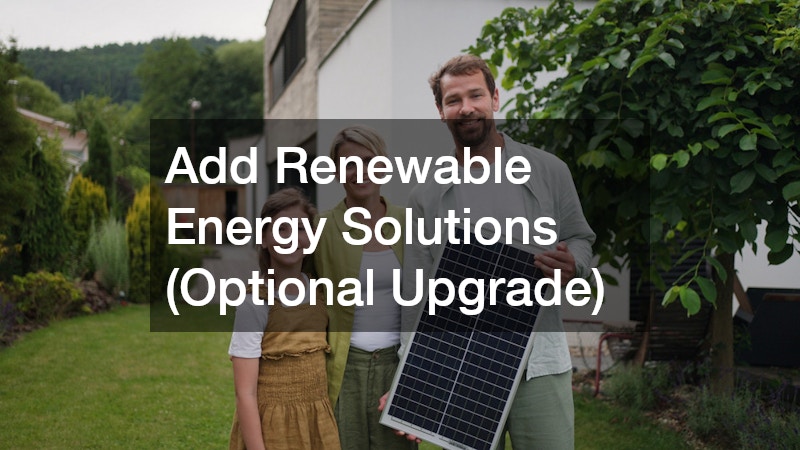Every homeowner wants a comfortable, efficient home without skyrocketing energy bills. Fortunately, reducing your monthly expenses doesn’t require an expensive overhaul or complete renovation. In fact, small, strategic upgrades to your home’s systems and structure can make a significant difference in your energy consumption and long-term costs.
From better insulation and upgraded lighting to routine HVAC care and efficient plumbing fixtures, simple changes can deliver measurable savings. Improving your home’s efficiency not only conserves energy—it also enhances comfort, extends the lifespan of your systems, and increases overall property value.
In this article, we’ll explore practical and affordable efficiency upgrades that help homeowners reduce utility bills and create a more sustainable, comfortable living environment.

Start With an Energy Audit
Before making any upgrades, it’s essential to understand where your home loses energy. A professional home energy audit is the best starting point. This detailed inspection evaluates your home’s insulation, air leaks, HVAC system, water use, and lighting to determine where you can make improvements.
Some homeowners choose to hire an expert for this process, while others perform a DIY audit using thermal cameras or energy meters. Professionals typically use advanced tools like blower doors to identify leaks around windows, doors, and ducts. The audit provides a prioritized list of improvements, so you know where your money and effort will have the most impact.
Even basic assessments—like feeling for drafts near windows or checking your attic insulation—can reveal easy fixes. Partnering with a reputable window company can help replace outdated windows with more energy-efficient models that prevent heat loss and reduce heating and cooling costs year-round.
Improve HVAC Efficiency
Replace or Maintain Your Filters Regularly
Your HVAC system is responsible for much of your home’s energy use, so keeping it efficient is key to lowering utility bills. Dirty filters restrict airflow, forcing your system to work harder and consume more electricity or fuel. Replace filters every one to three months, depending on usage and manufacturer recommendations.
This small maintenance step can improve air quality, reduce wear on equipment, and lower energy costs. For homeowners with central air, replacing filters regularly also helps avoid unnecessary HVAC repairs caused by clogged airflow or overheating.
Schedule Routine HVAC Maintenance
Preventative maintenance is one of the most effective ways to improve your system’s performance. Annual tune-ups identify worn parts, refrigerant leaks, or dirty coils before they cause bigger problems. These checks also optimize efficiency by ensuring your unit operates within manufacturer specifications.
Most HVAC companies offer maintenance packages that include inspection, cleaning, and system calibration. Properly maintained systems use less energy, provide more consistent heating and cooling, and last several years longer than neglected units.
Install a Smart Thermostat
Modern thermostats allow homeowners to automate temperature settings for maximum efficiency. By programming your heating and cooling schedule, you can reduce energy use when you’re away or asleep without sacrificing comfort.
Many smart thermostats even learn your habits over time and adjust automatically. Depending on the model, this upgrade can save up to 10–15% on heating and cooling costs each year. When combined with efficient insulation and sealed ductwork, the savings can be even greater.

Upgrade Lighting for Instant Savings
Switch to LED Bulbs
One of the fastest ways to reduce energy costs is by switching to LED lighting. LEDs consume up to 75% less energy than traditional incandescent bulbs and last up to 25 times longer. Over time, the savings from lighting alone can significantly lower your electricity bill.
Additionally, LED bulbs produce less heat, keeping rooms cooler in the summer. This contributes to lower cooling costs, especially in climates that rely heavily on air conditioning.
Use Motion Sensors or Dimmers
Lighting controls such as dimmers, timers, and motion sensors ensure that lights are only on when needed. Installing these tools in high-traffic areas like hallways, bathrooms, or garages prevents wasted energy and adds convenience.
A local electrical contractor can recommend and safely install these systems while ensuring they comply with local electrical codes. These small automation upgrades can collectively reduce your lighting costs by up to 20%.
Take Advantage of Natural Light
Maximize daylight by keeping windows clean and uncovering them during the day. Natural light not only cuts electricity use but also boosts mood and productivity. For rooms with limited sunlight, consider adding reflective surfaces or lighter wall colors to make spaces feel brighter without relying on artificial lighting.
Seal and Insulate for Better Temperature Control
Air leaks are one of the biggest culprits of energy waste in homes. Gaps and cracks around windows, doors, and walls allow heated or cooled air to escape, forcing your HVAC system to work harder.
Simple sealing techniques—like caulking window frames, weatherstripping doors, and insulating attics—can dramatically improve temperature control. Upgrading insulation in the attic and basement can reduce heating and cooling costs by as much as 15%.
When it comes to roofing and exterior upgrades, consulting a roofing expert can help identify areas of heat loss or poor ventilation. A well-insulated roof paired with proper attic ventilation keeps warm air inside during winter and hot air out during summer, ensuring year-round efficiency.
If your exterior walls are older, working with a siding contractor can further boost insulation performance and weather resistance. Modern siding materials not only enhance curb appeal but also provide better thermal protection against drafts and moisture.

Make Water Use More Efficient
Install Low-Flow Fixtures
Reducing water consumption saves both water and energy. Low-flow showerheads and faucets use significantly less water without compromising pressure, reducing the demand on your water heater. Many homeowners notice a drop in both their water and gas or electric bills after upgrading fixtures.
Check for Leaks
Leaky faucets, toilets, and pipes waste gallons of water every day. Even a small, hidden leak can cause a noticeable increase in your monthly utility bill. Performing regular plumbing checks—or scheduling a plumbing installation service—helps prevent costly water waste and potential damage.
Consider a Tankless Water Heater
Unlike traditional tanks that constantly heat and store water, tankless models heat water on demand. This reduces standby energy losses and ensures you only pay for what you use. While the upfront cost may be higher, the long-term efficiency benefits often outweigh the initial expense.
Upgrade Appliances and Electronics
Outdated appliances are among the largest energy drains in most homes. Replacing them with ENERGY STAR–certified models can cut energy use dramatically. Modern refrigerators, dishwashers, and washing machines use less water and electricity while offering advanced features for convenience.
Smart appliances can also be programmed to run during off-peak hours when utility rates are lower. Additionally, using smart power strips prevents “phantom” energy draw from electronics left plugged in.
Efficient homes also require proper sealing at access points. If your home has older doors that allow drafts, consider working with professionals who provide door replacement services. New, insulated doors help reduce energy loss and contribute to more stable indoor temperatures.

Add Renewable Energy Solutions (Optional Upgrade)
For homeowners looking to make a long-term investment in efficiency, renewable energy options are becoming increasingly affordable. Solar panels, geothermal systems, and even small wind turbines can offset a significant portion of your energy costs.
Some state and federal programs offer rebates or tax incentives to make these upgrades more accessible. When paired with efficiency improvements like insulation, energy-efficient windows, and an optimized HVAC system, renewable energy can make your home nearly self-sufficient.
If you’re upgrading multiple systems, don’t overlook your garage. Proper garage door opener installation ensures that your garage is sealed and insulated, preventing air leaks that could affect the temperature of adjacent rooms.
Monitor and Maintain Efficiency Year-Round
Improving efficiency isn’t a one-time effort—it requires regular monitoring and maintenance to sustain savings. Creating a seasonal checklist helps keep your systems running optimally throughout the year.
In the fall, schedule a furnace repair service or inspection to make sure your heating system is ready for colder temperatures. In the spring, have your air conditioner checked before peak summer heat. Clean gutters, check attic ventilation, and inspect insulation to ensure all systems function efficiently.
Routine maintenance also extends to plumbing, roofing, and electrical systems. For example, keeping wiring, panels, and outlets in good condition prevents overloads and energy waste. A professional inspection by a local electrical contractorcan verify safety and performance before issues become costly repairs.
Finally, sealing windows and doors regularly helps prevent drafts, while maintaining exterior components—such as siding and roofing—protects against water infiltration and insulation loss. If your windows are aging or damaged, consulting a window company for energy-efficient replacements can have an immediate effect on comfort and costs.
Home Envelope and Comfort Upgrades
The home’s “envelope”—its roof, walls, doors, and windows—plays a crucial role in overall energy efficiency. If you’ve noticed drafts, inconsistent temperatures, or condensation, it’s a sign that your home may need exterior improvements.
Modern siding and roofing materials, paired with efficient insulation, reduce heat transfer and lower energy demand. A roofing expert can evaluate whether your current roof is properly sealed, insulated, and ventilated, while a siding contractor can suggest materials that improve insulation and weather resistance.
Improving insulation isn’t limited to walls and roofs. Doors, windows, and even garage areas contribute to energy savings when properly insulated. Pairing these upgrades with energy-efficient lighting, HVAC maintenance, and smart technology creates a comprehensive strategy for utility reduction.
Interior Comfort and Air Quality
Energy efficiency isn’t only about saving money—it’s also about improving comfort and indoor air quality. Sealing gaps and maintaining HVAC systems help reduce allergens and pollutants in the air. Proper ventilation ensures a constant supply of fresh air while preventing humidity-related problems like mold.
During seasonal transitions, HVAC maintenance plays a critical role in sustaining indoor air quality. Many HVAC companies recommend regular duct cleaning and filter replacements to maintain airflow and efficiency. Additionally, programmable thermostats and zoning systems can help balance temperature distribution throughout the home.
Roofing, Siding, and Door Improvements
Exterior upgrades are often overlooked but make a huge difference in energy savings. A roofing expert can help identify leaks and insulation issues that cause heat loss during winter and heat gain in summer. Quality siding acts as a protective layer that keeps your home insulated and moisture-resistant year-round.
Replacing old, inefficient doors is another effective improvement. Modern entry doors are designed with advanced materials that reduce drafts and improve insulation. Choosing professional door replacement services ensures proper sealing and alignment, which helps maintain consistent indoor temperatures and lower energy costs.
Plumbing and Water Efficiency
Efficient plumbing systems are a critical yet underestimated part of home energy savings. Even a minor leak can increase both water and heating bills. Hiring a plumbing installation service to inspect your home’s pipes, faucets, and fixtures helps identify inefficiencies early.
Upgrading to modern plumbing fixtures and water heaters significantly reduces energy demand. Tankless or hybrid water heaters provide hot water on demand, eliminating the need to constantly heat large water tanks. Low-flow fixtures conserve water while maintaining pressure and comfort.
Electrical and System-Wide Efficiency
Electrical systems play a direct role in home energy consumption. Faulty wiring, overloaded circuits, or outdated panels can increase energy waste and risk safety hazards. Scheduling inspections with a local electrical contractor helps identify inefficiencies and opportunities for upgrades, such as LED lighting, motion sensors, or smart plugs.
Smart home systems are another way to enhance control and monitor usage. Devices that track consumption can help you make informed decisions about when and how to use energy more efficiently. Over time, these adjustments lead to noticeable savings on monthly utility bills.
Furnace and Seasonal Care
When temperatures drop, your furnace becomes one of the most energy-hungry systems in your home. Before winter arrives, schedule a furnace repair service or inspection to ensure optimal performance. Technicians can clean filters, check for leaks, and fine-tune components for efficiency.
Proper furnace maintenance not only improves energy use but also prevents unexpected breakdowns during the coldest months. When combined with adequate insulation and air sealing, a well-maintained furnace helps create a warm, comfortable environment with lower operating costs.
Long-Term Investment and Savings
Energy efficiency is both a short-term cost reducer and a long-term investment. Homeowners who commit to ongoing upgrades often see lower monthly bills, improved comfort, and increased resale value.
Beyond basic upgrades, larger improvements like solar panels, efficient roofing, and insulated siding yield impressive returns over time. The more systems you optimize—HVAC, plumbing, electrical, insulation—the greater your energy independence and financial savings become.
Even seemingly minor upgrades, such as a garage door opener installation that seals out drafts, contribute to overall efficiency. Collectively, these small improvements add up to substantial long-term benefits.
Reducing utility bills doesn’t have to mean cutting comfort or undergoing major renovations. Simple, strategic efficiency upgrades—like sealing air leaks, maintaining your HVAC system, replacing outdated appliances, and improving insulation—can dramatically lower energy use and monthly costs.
Whether you begin with a home energy audit, improve HVAC performance, or upgrade lighting and plumbing, every improvement makes a measurable difference. Over time, these upgrades also help protect your home’s structure, enhance air quality, and boost overall property value.
Take small steps today toward a more efficient, comfortable, and cost-effective home. From HVAC maintenance and water conservation to better insulation and renewable energy options, each improvement brings you closer to lower utility bills and a greener future.


